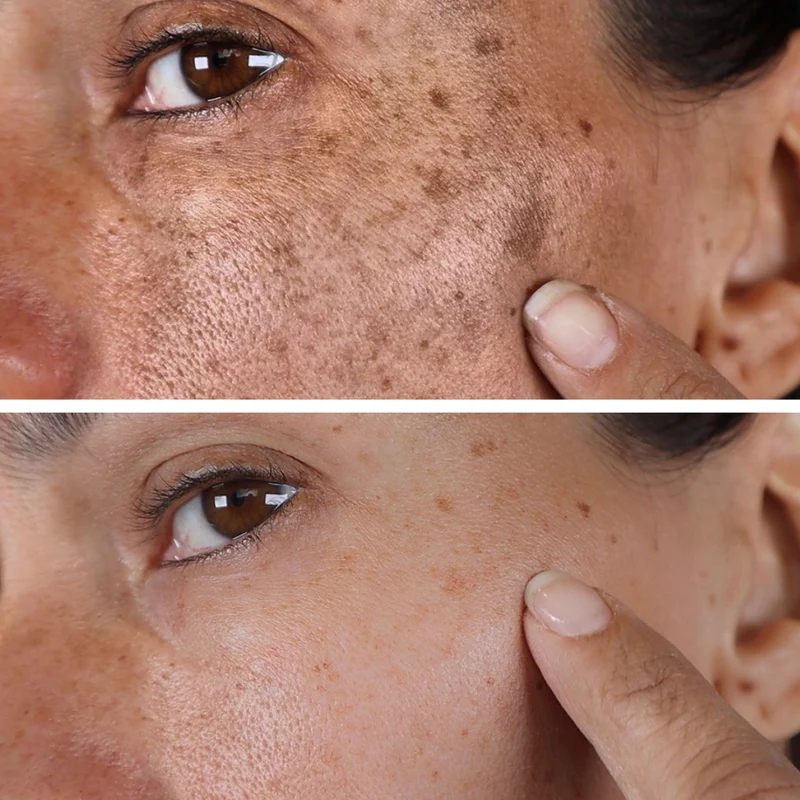Understanding Chemical Peels
Peel Process
Chemical peels work by removing the outer layer of skin. This process uncovers a smoother, less pigmented layer beneath. They apply specific acids to the skin, causing it to exfoliate and eventually peel off.
The new skin is usually smoother and less flawed than the old skin. It’s important to know that this new layer is also more sensitive to the sun.
Acid Types
Selecting the right type of acid is crucial for effective results. For dark spots, glycolic acid and lactic acid are often recommended. These acids target pigmentation without being too harsh on the skin.
Professionals can help choose the best option based on your skin type and concerns. This ensures desired outcomes while minimizing potential side effects.
Cell Turnover
Chemical peels accelerate cell turnover, promoting skin renewal. This process helps in fading dark spots and improving overall skin texture. By shedding old, pigmented cells, chemical peels make way for fresh, new cells.
This rejuvenation effect is what makes chemical peels a popular choice for those looking to enhance their complexion.
Causes of Dark Spots
Sun Exposure
Excessive sun exposure is a leading cause of dark spots. UV rays accelerate melanin production, creating brown spots or age spots on the skin. Individuals often notice these blotches after years of sun damage.
Sunscreen can reduce further pigmentation. Yet, existing dark spots may remain visible without targeted treatments like chemical peels.
Aging Process
As people age, their skin undergoes various changes. Melanin clusters can form, leading to hyperpigmentation. These are commonly known as age spots and appear in areas frequently exposed to the sun.
Moisturizers and serums might offer minimal improvement. However, professional interventions provide more significant results.
Hormonal Changes
Hormonal fluctuations can trigger melasma. This condition causes brown or gray patches, mainly on the face. Pregnancy and birth control pills are typical triggers for women.
Topical treatments help but don’t always fully eliminate melasma. Chemical peels offer a deeper solution by removing the top layer of skin.
Inflammation
Injuries or acne can lead to inflammatory hyperpigmentation. This results in dark spots at injury sites or where inflammation occurred.
Gentle skincare routines can soothe the skin. For persistent discoloration, chemical peels might be recommended to even out skin tone.
Genetic Factors
e individuals have a genetic predisposition to develop dark spots. Their skin naturally produces more melanin in response to various factors like sun exposure or injury.
While genetics cannot be changed, preventive measures and treatments like chemical peels can manage the appearance of dark spots effectively.
Benefits of Chemical Peels
Non-Invasive Solution
Chemical peels offer a gentle yet effective method to reduce dark spots. They work by removing the top layer of skin, revealing fresher, more even-toned skin beneath. This process is non-invasive, making it a preferred option for those wary of surgical procedures.
Dark spots often stem from sun damage or acne scars. Chemical peels address these issues without requiring downtime. Patients can resume their daily activities immediately after treatment.
Versatility
Beyond tackling hyperpigmentation, chemical peels excel in improving skin texture and clarity. They are effective against acne, fine lines, and wrinkles, offering a comprehensive skincare solution.
Their ability to penetrate deep into the skin helps unclog pores and remove dead skin cells. This action prevents future breakouts and promotes smoother skin.
Long-Term Benefits
Regular treatments with chemical peels can yield significant long-term improvements in skin health. They stimulate collagen production, essential for maintaining youthful, resilient skin.
Over time, patients notice not just reduced dark spots, but also firmer, more radiant skin. This cumulative effect underscores the value of incorporating chemical peels into a holistic skincare regimen.
In essence, chemical peels provide a versatile and non-invasive path to addressing dark spots and other common skin concerns. Their ability to improve overall skin tone and texture while offering long-term benefits makes them a valuable tool in achieving healthy, glowing skin.
Types of Chemical Peels
Light Peels
Light chemical peels gently exfoliate the skin, targeting only the outermost layer. They are ideal for treating mild discoloration and rough skin texture. Recovery time is minimal, often requiring just a few days for the skin to heal.
These peels suit all skin types, including sensitive skin. They use mild acids like alpha-hydroxy acid (AHA) to brighten the complexion without significant downtime.
Medium Peels
Medium peels penetrate deeper, reaching the middle layers of skin. They effectively treat dark spots, fine lines, and wrinkles. Recovery can take up to a week, with noticeable flaking and redness during this period.
They are best suited for individuals with moderate skin issues who can tolerate a bit more intensity. Glycolic or trichloroacetic acid (TCA) are commonly used in these treatments to achieve more dramatic results.
Deep Peels
Deep chemical peels offer the most intensive treatment, addressing severe discolorations, scars, and wrinkles. These peels penetrate several layers of skin and require significant recovery time, often several weeks.
Due to their intensity, deep peels are recommended for those with resilient skin types or severe skin conditions. Phenol is typically the active ingredient used in these treatments.
Innovative formulations now combine various acids to minimize discomfort and reduce recovery time. These advancements allow individuals to enjoy profound results with less downtime, making chemical peels more accessible and convenient for busy lifestyles.
Choosing the Right Peel
Skin Assessment
Consulting with a dermatologist is crucial. They can assess your skin type and condition. This helps in choosing the right peel for you.
A professional can recommend a peel that targets dark spots effectively. They consider your skin’s tone and texture. This ensures the selected peel provides the best results.
Lifestyle Consideration
Your lifestyle influences the choice of peel intensity. It’s important to consider your available downtime.
Stronger peels require more recovery time. If your schedule is tight, a lighter peel might be better. It offers less downtime but still improves skin appearance.
Starting Light
For newcomers, starting with a lighter peel is wise. It allows you to gauge how your skin reacts.
Lighter peels gently remove the top layer of skin. This reduces dark patches without harsh effects. Over time, you can opt for stronger solutions if needed.

Preparing for a Chemical Peel
Medication Review
Before undergoing a chemical peel, it’s crucial to review your current medications with a healthcare provider. Certain medications can increase skin sensitivity, potentially complicating the peeling process. They may advise pausing or adjusting these medications well in advance of the treatment.
Avoiding specific skincare products that might irritate the skin or heighten sensitivity is also essential. Products containing retinol, benzoyl peroxide, and salicylic acid should be set aside at least one week before the procedure.
Skincare Routine
Adapting your skincare routine is key to preparing your skin for a chemical peel. Incorporating gentle cleansers and moisturizers can help maintain skin balance without causing additional stress. It’s also important to start this modified routine at least two weeks before your scheduled peel.
Sun protection becomes even more critical during this period. Applying a broad-spectrum sunscreen daily helps prevent premature damage and ensures your skin is in optimal condition for the peel.
Conditioning Treatments
Skin conditioning treatments can significantly enhance the outcomes of your chemical peel. These treatments, often recommended by professionals, aim to prime the skin, boosting collagen production and improving overall texture. Starting these treatments about four weeks before your chemical peel can reduce potential side effects and promote a smoother recovery process.
What to Expect During and After
Sensation During
Patients often report a tingling or burning sensation during the chemical peel process. This discomfort is temporary, usually lasting for a few minutes until the solution is neutralized. The duration of the procedure varies but typically does not exceed an hour.
Post-Peel Care
Aftercare is crucial for healing and achieving the best results. It includes moisturizing regularly and applying sunscreen to protect the treated areas from sun exposure. Patients should follow their dermatologist’s instructions closely, which might also involve avoiding certain products that could irritate the skin.
Healing Timeline
The recovery time after a chemical peel can differ based on the peel’s intensity and the patient’s skin type. Generally, patients begin to see peeling within a few days, and this can last up to a week. The skin may appear red or feel sensitive during this period.
Follow-Up Treatments
For sustained improvements in dark spots and other aging issues, multiple treatments may be needed. Patients typically schedule follow-up peels every 4-6 weeks, depending on their skin’s response and their medical history.
Ideal Candidates for Chemical Peels
Skin Concerns
Individuals with specific skin concerns, such as dark spots, fine lines, and acne scars, often find chemical peels beneficial. These treatments work by removing dead skin cells, leading to a more even complexion.
Those struggling with acne may also see improvements. Chemical peels help clear pores and reduce the appearance of scars over time.
Skin Type
Not all skin types react the same way to chemical peels. People with sensitive skin should proceed with caution. A dermatologist can assess your skin type and recommend the most suitable peel intensity.
It’s crucial to understand that certain skin conditions could worsen with chemical peels. Those with active infections, or a history of poor wound healing, might need to avoid this treatment.
Professional Evaluation
Before deciding on a chemical peel, it’s essential to consult a dermatologist. They can evaluate your skin concerns and health history. This step ensures you are a good candidate for the procedure.
A professional assessment helps tailor the treatment plan to your needs. It maximizes safety and effectiveness while minimizing risks.
Final Remarks
Chemical peels offer a promising solution for those of you struggling with dark spots, providing a way to achieve clearer, more radiant skin. By understanding the types available and how they work, you’re equipped to make informed decisions about which peel might be best for your unique skin concerns. Remember, choosing the right peel and preparing adequately are key steps to ensure you get the most out of this treatment while minimizing potential risks. The journey to brighter, spot-free skin is well within reach with the right approach and professional guidance.
Now’s the time to take action. Consult with a skincare professional who can assess your skin’s needs and recommend the most suitable chemical peel option for you. Embrace the opportunity to transform your skin and boost your confidence. Don’t let dark spots hold you back any longer—explore the benefits of chemical peels today.
Frequently Asked Questions
What are chemical peels?
Chemical peels are skin-resurfacing treatments that remove the top layers of the skin to improve its appearance, especially for reducing dark spots.
How do chemical peels help with dark spots?
Chemical peels exfoliate the damaged outer layers of skin, revealing a brighter, more even complexion underneath.
What types of chemical peels are available?
There are three main types: superficial, medium, and deep peels, each targeting different skin concerns and depths.
How do I choose the right chemical peel for my dark spots?
Consulting with a dermatologist is crucial. They can assess your skin type and condition to recommend the most effective peel.
What should I expect during a chemical peel treatment?
Expect a brief application of the chemical solution to your skin, which may cause mild discomfort or tingling. The duration depends on the type of peel.
Who is an ideal candidate for chemical peels?
Ideal candidates are those looking to improve their skin’s appearance by reducing dark spots, fine lines, or acne scars, with realistic expectations about outcomes.
How should I prepare for a chemical peel?
Follow your dermatologist’s advice closely. This may include avoiding certain medications or skincare products and staying out of the sun before treatment.





